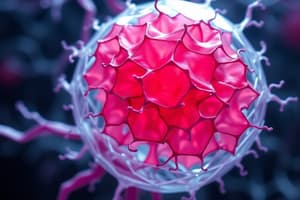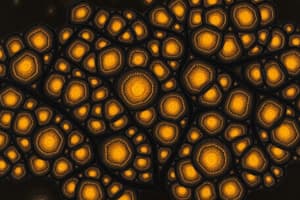Podcast
Questions and Answers
What is the primary function of the nucleus in a cell?
What is the primary function of the nucleus in a cell?
- Package and modify synthesized proteins
- Synthesize proteins using ribosomes
- Store genetic material and facilitate transcription (correct)
- Detoxify harmful substances
Which structure is responsible for synthesizing proteins that will be secreted from the cell?
Which structure is responsible for synthesizing proteins that will be secreted from the cell?
- Smooth endoplasmic reticulum
- Rough endoplasmic reticulum (correct)
- Golgi apparatus
- Nucleus
What role does the Golgi apparatus play in a cell?
What role does the Golgi apparatus play in a cell?
- Facilitate transcription of DNA
- Package and modify proteins (correct)
- Store calcium ions
- Synthesize amino acids
What is a key function of the smooth endoplasmic reticulum?
What is a key function of the smooth endoplasmic reticulum?
Which part of the ribosome is responsible for binding to mRNA during translation?
Which part of the ribosome is responsible for binding to mRNA during translation?
What is the primary function of ribosomes in protein synthesis?
What is the primary function of ribosomes in protein synthesis?
Which part of the mitochondria is responsible for oxidative phosphorylation?
Which part of the mitochondria is responsible for oxidative phosphorylation?
Which structure within the chloroplast is involved in capturing solar energy for photosynthesis?
Which structure within the chloroplast is involved in capturing solar energy for photosynthesis?
What indicates that mitochondria may have originated from prokaryotes?
What indicates that mitochondria may have originated from prokaryotes?
What role do lysosomes play in the cell?
What role do lysosomes play in the cell?
What type of molecules can primarily pass through the membrane via simple diffusion?
What type of molecules can primarily pass through the membrane via simple diffusion?
How do facilitated diffusion and active transport differ fundamentally?
How do facilitated diffusion and active transport differ fundamentally?
What type of transport protein is responsible for binding and carrying substances across the membrane?
What type of transport protein is responsible for binding and carrying substances across the membrane?
Which process is specifically utilized for the intake of large particles into a cell?
Which process is specifically utilized for the intake of large particles into a cell?
What characterizes active transport in cellular processes?
What characterizes active transport in cellular processes?
What is the primary function of hydrolytic enzymes in cells?
What is the primary function of hydrolytic enzymes in cells?
What role does the central vacuole play in plant cells?
What role does the central vacuole play in plant cells?
Why is a high surface area to volume ratio considered favorable for cells?
Why is a high surface area to volume ratio considered favorable for cells?
What is the main purpose of cholesterol in the plasma membrane?
What is the main purpose of cholesterol in the plasma membrane?
Which of the following accurately describes simple diffusion?
Which of the following accurately describes simple diffusion?
Flashcards
Nucleus
Nucleus
A double membrane-bound organelle that stores genetic material (DNA), synthesizes RNA (transcription), and assembles ribosomes.
Rough Endoplasmic Reticulum (RER)
Rough Endoplasmic Reticulum (RER)
A membrane-bound organelle studded with ribosomes, responsible for protein synthesis and modification, particularly for proteins destined for secretion.
Smooth Endoplasmic Reticulum (SER)
Smooth Endoplasmic Reticulum (SER)
An extension of the ER without ribosomes, involved in detoxification, lipid synthesis, and calcium storage.
Golgi apparatus
Golgi apparatus
Signup and view all the flashcards
Ribosome
Ribosome
Signup and view all the flashcards
Mitochondria: What is its function?
Mitochondria: What is its function?
Signup and view all the flashcards
What are cristae?
What are cristae?
Signup and view all the flashcards
Where does oxidative phosphorylation occur?
Where does oxidative phosphorylation occur?
Signup and view all the flashcards
Where does the citric acid cycle occur?
Where does the citric acid cycle occur?
Signup and view all the flashcards
What are lysosomes?
What are lysosomes?
Signup and view all the flashcards
Vacuoles: What are they?
Vacuoles: What are they?
Signup and view all the flashcards
Central Vacuole: What does it do?
Central Vacuole: What does it do?
Signup and view all the flashcards
Contractile Vacuole: What's its function?
Contractile Vacuole: What's its function?
Signup and view all the flashcards
Food Vacuole: What's it for?
Food Vacuole: What's it for?
Signup and view all the flashcards
Surface Area to Volume Ratio: What's the relationship?
Surface Area to Volume Ratio: What's the relationship?
Signup and view all the flashcards
Simple Diffusion
Simple Diffusion
Signup and view all the flashcards
Facilitated Diffusion
Facilitated Diffusion
Signup and view all the flashcards
Active Transport
Active Transport
Signup and view all the flashcards
Phagocytosis
Phagocytosis
Signup and view all the flashcards
Pinocytosis
Pinocytosis
Signup and view all the flashcards
Study Notes
Cell Structure and Function
- Nucleus:
- Contains DNA, the genetic material.
- Composed of a double membrane (nuclear envelope) with pores.
- Pores allow mRNA to exit for translation and proteins/enzymes to enter for transcription.
- Stores genetic material (DNA/RNA).
- Site of transcription (RNA synthesis).
- Assembles ribosomes (using rRNA).
- Rough Endoplasmic Reticulum (Rough ER):
- Network of flattened sacs connected to the nuclear envelope.
- Studded with ribosomes, facilitating protein synthesis within a membrane.
- Synthesizes secreted proteins (exocytosis).
- Important for cell compartmentalization and mechanical support.
- Involved in intracellular transport (vesicle movement).
- Smooth Endoplasmic Reticulum (Smooth ER):
- Extension of Rough ER, no ribosomes.
- Critical for detoxification of harmful substances.
- Stores calcium ions (Ca²⁺) in muscle cells, acting as a secondary messenger in cell signaling pathways.
- Site of lipid synthesis (steroids, other lipids).
- Golgi Apparatus (Golgi):
- Stacks of flattened sacs.
- Packages and modifies proteins and other macromolecules (carbohydrates) made by the Rough ER.
- Involved in protein transport to the plasma membrane for secretion.
- Ribosomes:
- Composed of a large and small subunit, both made of rRNA and proteins.
- Synthesize proteins via translation, reading mRNA.
- Can be free in the cytoplasm or bound to the Rough ER.
- Mitochondria:
- Double membrane: outer membrane and inner membrane (cristae).
- Cristae are highly folded (increased surface area) for oxidative phosphorylation.
- Contains its own DNA and ribosomes (endosymbiotic theory).
- Site of oxidative phosphorylation (third step of cellular respiration).
- Matrix (inner space of the cristae) is the site of the Krebs/citric acid cycle (second step of cellular respiration).
- Glycolysis occurs in the cytoplasm.
- Chloroplasts:
- Triple membrane (outer, inner, thylakoid).
- Thylakoids are stacks of sacs containing chlorophyll, which absorbs light energy for photosynthesis.
- Stroma (fluid within chloroplast) contains the Calvin cycle.
- Contains its own DNA and ribosomes (endosymbiotic theory).
- Site of photosynthesis.
- Lysosomes:
- Membrane-bound sacs containing hydrolytic enzymes.
- Function in intracellular digestion.
- Recycles cell's organic material.
- Involved in programmed cell death (apoptosis).
- Vacuoles:
- Membrane-bound sacs with diverse functions.
- Storage of macromolecules and cellular waste products.
- Central Vacuole (plants): Water retention, turgor pressure for rigidity.
- Contractile Vacuole (single-celled organisms): Osmoregulation, expelling excess water from cells.
- Food Vacuole: Formed by phagocytosis; fuses with lysosomes for digestion.
Cellular Transport and Membranes
-
Plasma Membrane:
- Phospholipid bilayer (hydrophilic heads, hydrophobic tails).
- Cholesterol (buffers fluidity).
- Proteins (facilitate transport).
- Glycolipids and glycoproteins (cell communication).
-
Membrane Transport (Passive):
- Simple Diffusion:
- Movement of small, non-polar molecules (O₂, CO₂, steroids) down a concentration gradient, directly through the membrane.
- Small amounts of water also move without aid of channels.
- Facilitated Diffusion:
- Movement of polar or charged molecules down a concentration gradient.
- Channel proteins allow molecules to pass through the membrane.
- Carrier proteins physically bind to molecules and carry them across.
- Simple Diffusion:
-
Membrane Transport (Active):
- Requires energy (ATP).
- Moves molecules against their concentration gradient.
- Often uses carrier proteins (pumps).
-
Bulk Transport:
- Endocytosis: Bringing material into cell.
- Phagocytosis (cellular eating): Ingesting large particles via pseudopods.
- Pinocytosis (cellular drinking): Ingesting extracellular fluid.
- Receptor-mediated endocytosis: Specific molecules bind to receptors to initiate engulfment.
- Exocytosis: Materials transported out of cell using vesicles.
- Endocytosis: Bringing material into cell.
-
Osmosis:
- Movement of water across a semi-permeable membrane.
- Hypertonic: High solute concentration, low water potential; water moves out.
- Hypotonic: Low solute concentration, high water potential; water moves in.
- Isotonic: Equal solute and water concentrations; water moves in and out equally.
Surface Area-to-Volume Ratio
- Cells with a high surface area-to-volume ratio are more efficient for diffusion and exchange of materials
Cell sizes
- Smaller cells are more efficient for transport within the cell than larger cells
Studying That Suits You
Use AI to generate personalized quizzes and flashcards to suit your learning preferences.




